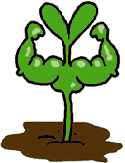| |
|
|
| |
To acclimate a plant to
harsher conditions. To make a plant or tissue resistant to any
environmental extreme such as low temperature, intense sun
exposures, heat, drought, wind etc. by gradually exposing and
habituate them to less protection. |
|
| |
|
|
The term hardening off
is usually utilized in horticulture to describe to the gradual
acclimatisation of seedlings grown, in a greenhouse or in other
protected environment to living outdoors into harsher definitive
growing conditions. The hardening off process is necessary to
reduce transplant shock.
Hardening off also indicate to the acclimatization of plants
over-wintered in a house in order to move them outdoors in
spring by gradually habituating them to external condition.
|
   |
HARDENING OFF SEEDLINGS
Some week before transplanting your seedlings outdoors or in
their definitive growing condition, start to harden them off.
This process acclimates the soft and tender plants, which have
been protected from wind, cool temperatures, and strong sun, to
their new environment.
First as soon seedlings grow enough start widening the slits in
the covers, than move the plants to a shady area or frame and
begin to give much air and space, and bring them indoors for the
night if night temperatures are cold. Each day, move them out
into the sun for a few hours, increasing the time spent in the
sun each day. Never be in a rush to plant or move your plants
outdoor the first week. You are more likely to lose than gain,
if external condition became too extreme, be patient and be sure
your plant are completely hardened.
After that treat as adult plants. |
|
 |
|
| |
|
|
|